Just a few updates tonight. We’d changed plans slightly when we left Klamath Falls on Monday. We were supposed to go to Renton, but Ann was suffering from some brain fluid issues again (pressure, head ache, nausea), so we hightailed it straight to Pasco. I guess this trip was just a little too long for her. Once we got her home and she could lay down, she felt a little better.
On Wednesday, she still wasn’t feeling great, so I brought Patterson up to Renton by myself. Yesterday, I had the time to do some work. Unfortunately, I discovered something a little disheartening. More on that later ….
I began the morning with a simple task: remove the column shifter handle and replace it with Rusty’s. The lever at the top is Rusty’s (it should be chrome rather than black, but that will have to wait). On the bottom is Patterson’s broken one. Patterson’s may be repairable, but it will take some time.
For comparison, here’s a CJ-2A shifter (this site shows how to assemble a CJ-2A column shift mechanism). It’s got a little more primitive looking end:
One of the first things I had to figure out was how to mount the anti-rattle spring.
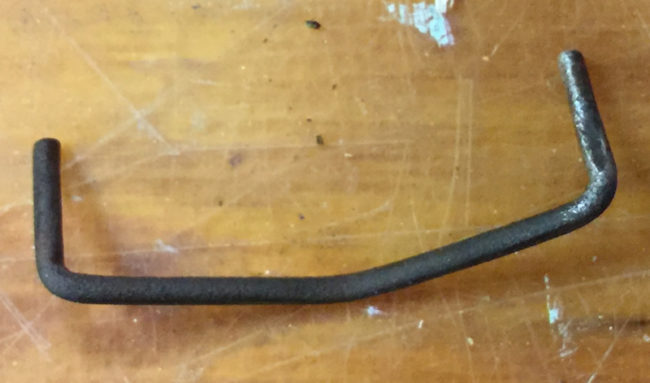
This spring is slightly different from the spring used on CJ-2A column shifters.
For comparison, here is a CJ-2A spring drawing:
After spotting a flattened portion (on the right side), I was able to correctly insert the spring,
Things were going good … a little too good. When I tried to insert the shifter into Patterson’s column, it would quite fit. After trying different strategies, I still couldn’t make it work. So, I examined both shifters more carefully.
What I discovered was that the tip of Rusty’s shifter was longer than Patterson’s, which explained why the shifter wouldn’t quite fit.
So, I shaved off a little on the end with a bench grinder. That did the trick.
Here’s a comparison of the shift knobs. Rusty’s is on the right and Patterson’s on the left. Looks like both are the same and appear original. Unfortunately, Rusty’s is quite weathered.
After getting the shifter set up, I set the choke and starter the engine. It fired right up! I ran it for a few minutes, but then it started running a little rougher. Eventually, it stopped running. I started it a couple more times, but it just got rougher. That’s when I noted the engine oil light was on.
Hmmm …
I went to the front of the jeep and pulled the dipstick to see just how much oil was in there. Instead of seeing black oil, I pulled out a dipstick with something resembling a gray Poi,
Well, that’s bad. I decided to drain the oil. Here’s a sample of some of it.
Looks a lot like freshly mixed concrete! So, I’ll need to pull the head off of the engine and see if there’s a head gasket issue. If not, I may have a big problem.


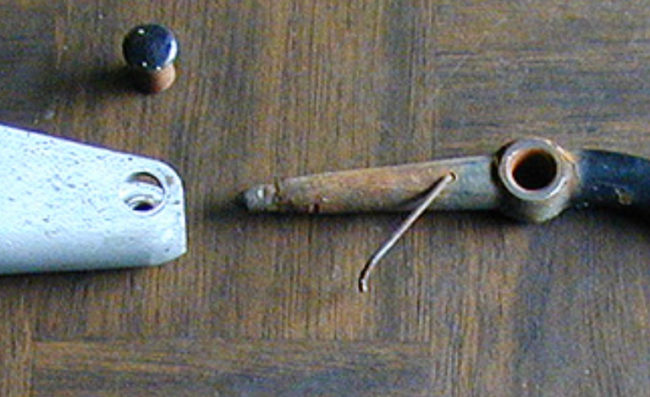

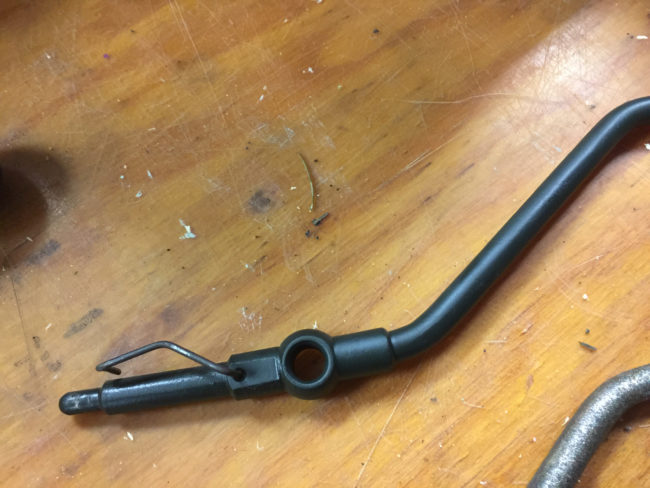
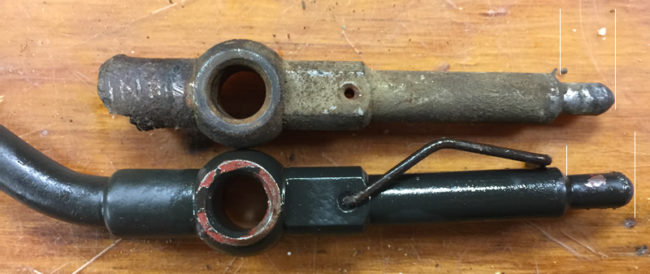

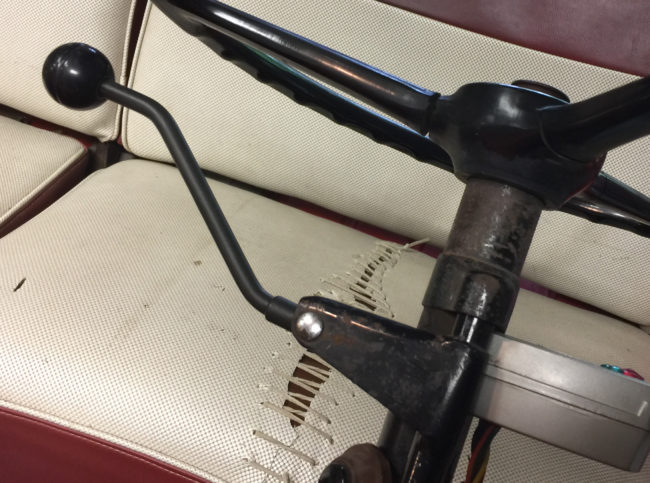
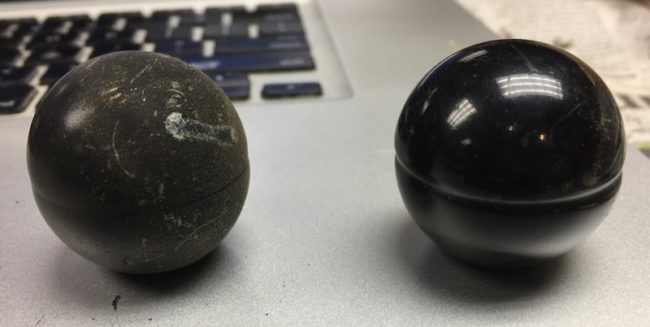
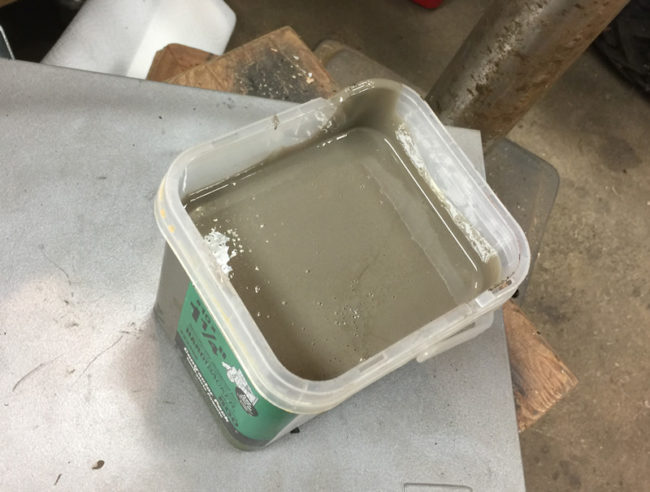

Hope Ann gets well quickly! Surely Patterson didn’t come from a place of very low temps but did you check the type fluid in the radiator? No blown freeze plugs. The way it started up right away I believe the gasket let go from the shock of not being started in a while. Then it started to let more and probably into the adjacent cylinder. But let’s all us out here know! Just sounds like Patterson’s Apricots are old and low hanging fruit. It happens you know.
Just some friendly advise, The first thing I do when I buy a vehicle, is pull the dip stick and check the oil. Check all the fluids for that matter. With all due respect Dave, I think you’re a bit too impulsive when it comes to buying & restoring Willys Jeep vehicles. You have to look at the big picture, if you start pulling apart another Jeep, the “odds” are 50- 50 that you’ll have it ready for the Alaska run.
Just my observations from a lifetime of experience, hope to add your already vast knowledge of the subject, not detract from it.
Column shift on craigslist from a wagon:
https://pittsburgh.craigslist.org/pts/6114763146.html
You could develop a collection and compare the sizes… LOL
Mike: It’s not so much an issue of being impulsive, after all I’ve only bought 2 jeeps in the last ten years. The issue is being too trusting. The jeep was as solid as they claimed, it started right up and ran well when tested multiple times, just as they claimed. I just forgot to pull the dipstick.
Barry: Let’s hope that is all it is!
Dave, no matter what you’re working on there’s always someone out there ready to tell you what you did wrong, what you should have done and voicing dire predictions concerning the results of your actions. You’ve discovered a problem with Patterson’s engine and are working towards a solution, that sounds like a good plan to me. Let us know if the Goddess and I can help you in any way. We’re looking forward to meeting you and as many of the Alaska Or Rust folks that can stop by for a visit. Take care and have fun
Paul: Thanks, and I do have a plan of action. I’m sure I will get it working. Fortunately, the mechanicals are easier to fix/replace than the task of doing body work. But, Mike is correct: I should have pulled the dipstick (I just got distracted) which probably would have revealed the oil issue. Hopefully, my mistake benefits others.
Craig: It would be useful to group all the column shift mechanisms together to compare them. The more we know, the better.
Dave, Glad we all can come to an understanding and conciseness on the subject. I never want to offend anybody, just want to be honest with my opinions among friends.
Dave,
We have all been in your situation before. I once had a farmer come into the shop to have his auction buy tractor looked at. This man was the most methodical man there was in regards to equipment maintenance, of all our customers. On this tractor, he checked the oil, listened to it run, and went over it with a fine tooth comb. The engine had a miss in the number three cylinder, but everything looked good. He purchased the tractor and brought it home. He spent the next week trying to remedy the miss. Flustered, he brought it by the shop to see if we could figure it out. First we took a compression test, (100, 95, 0, 100). The number three cylinder didn’t even make the needle on the gauge fluctuate. In short, the liner on number three had a crack leading to the water jacket. The previous owner removed the piston and connecting rod, then drove a piece a soft wood log down the liner. When the wood expanded, it sealed the crack. He took the rod bearing and hose clamped it to the crank. I’m not sure how much time was spent on this field repair, but another $30 for a liner probably wouldn’t have broke the bank.
We will all be following your progress, and will be pulling for you to succeed.
Seems to me you should be able to get Patterson finished easier and with less time than trying to finish rusty. Not sure why you aren’t taking bisket, you could be spending more time on promoting the Alaska or bust trip.
Most of us have learned the old lesson that experience is a great teacher, and that working on these is going to be an adventure sometimes. That’s how you learn. I say full speed ahead and damn the torpedoes. Keep the chin up Dave.
Looks like a head gasket to me too…hopefully not a big issue